Critical Appraisal of Research Article: HLSC122 Assessment 3 Report
VerifiedAdded on 2022/11/28
|6
|1981
|354
Report
AI Summary
This report presents a critical appraisal of the research article "Drug Checking: A prevention measure for a heterogeneous group with high consumption frequency and polydrug use - evaluation of zurich’s drug checking services." The appraisal assesses authorship, research questions, design, methods, results, limitations, and the applicability of findings. The report highlights the strengths and weaknesses of the study, including the clarity of research questions, the appropriateness of the research design, and the limitations in data analysis and reporting. The study's findings are then applied to a real-life scenario, considering the enablers and barriers to the use of research findings in the context of drug testing at music festivals. The report concludes that the study has limitations and that further research is needed to provide robust evidence. It also highlights the importance of considering evidence-based practices in healthcare decision-making.
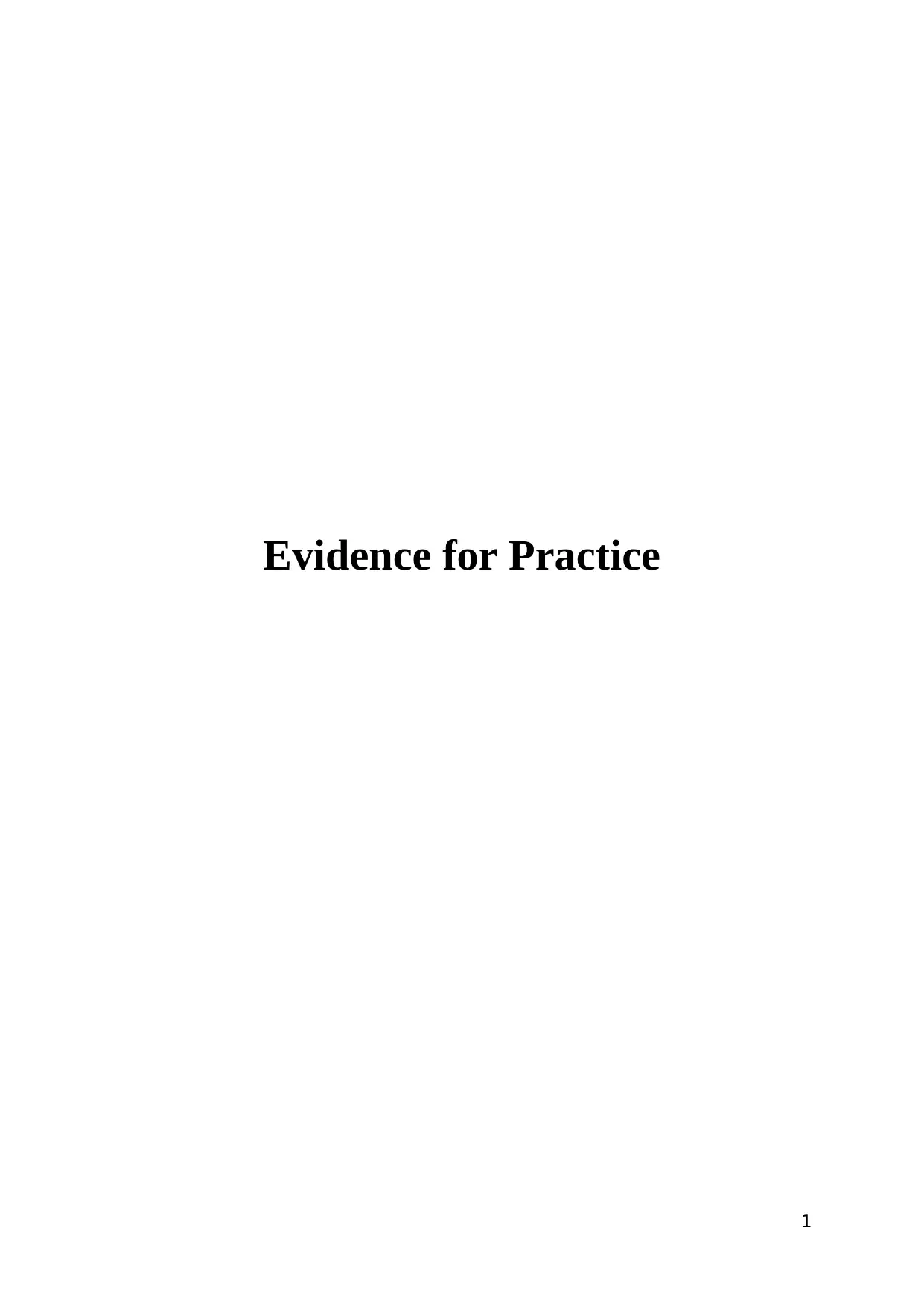
Evidence for Practice
1
1
Paraphrase This Document
Need a fresh take? Get an instant paraphrase of this document with our AI Paraphraser
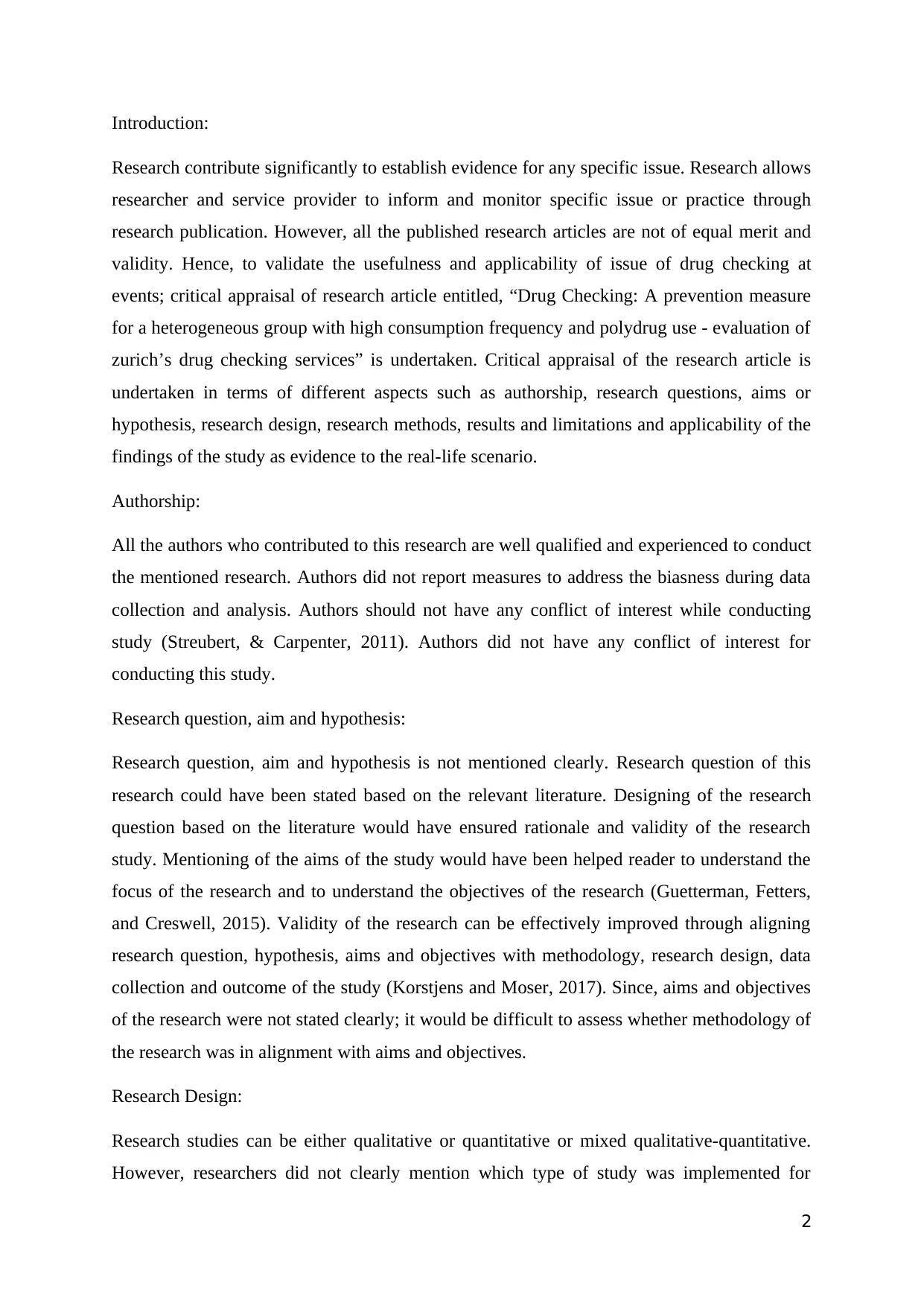
Introduction:
Research contribute significantly to establish evidence for any specific issue. Research allows
researcher and service provider to inform and monitor specific issue or practice through
research publication. However, all the published research articles are not of equal merit and
validity. Hence, to validate the usefulness and applicability of issue of drug checking at
events; critical appraisal of research article entitled, “Drug Checking: A prevention measure
for a heterogeneous group with high consumption frequency and polydrug use - evaluation of
zurich’s drug checking services” is undertaken. Critical appraisal of the research article is
undertaken in terms of different aspects such as authorship, research questions, aims or
hypothesis, research design, research methods, results and limitations and applicability of the
findings of the study as evidence to the real-life scenario.
Authorship:
All the authors who contributed to this research are well qualified and experienced to conduct
the mentioned research. Authors did not report measures to address the biasness during data
collection and analysis. Authors should not have any conflict of interest while conducting
study (Streubert, & Carpenter, 2011). Authors did not have any conflict of interest for
conducting this study.
Research question, aim and hypothesis:
Research question, aim and hypothesis is not mentioned clearly. Research question of this
research could have been stated based on the relevant literature. Designing of the research
question based on the literature would have ensured rationale and validity of the research
study. Mentioning of the aims of the study would have been helped reader to understand the
focus of the research and to understand the objectives of the research (Guetterman, Fetters,
and Creswell, 2015). Validity of the research can be effectively improved through aligning
research question, hypothesis, aims and objectives with methodology, research design, data
collection and outcome of the study (Korstjens and Moser, 2017). Since, aims and objectives
of the research were not stated clearly; it would be difficult to assess whether methodology of
the research was in alignment with aims and objectives.
Research Design:
Research studies can be either qualitative or quantitative or mixed qualitative-quantitative.
However, researchers did not clearly mention which type of study was implemented for
2
Research contribute significantly to establish evidence for any specific issue. Research allows
researcher and service provider to inform and monitor specific issue or practice through
research publication. However, all the published research articles are not of equal merit and
validity. Hence, to validate the usefulness and applicability of issue of drug checking at
events; critical appraisal of research article entitled, “Drug Checking: A prevention measure
for a heterogeneous group with high consumption frequency and polydrug use - evaluation of
zurich’s drug checking services” is undertaken. Critical appraisal of the research article is
undertaken in terms of different aspects such as authorship, research questions, aims or
hypothesis, research design, research methods, results and limitations and applicability of the
findings of the study as evidence to the real-life scenario.
Authorship:
All the authors who contributed to this research are well qualified and experienced to conduct
the mentioned research. Authors did not report measures to address the biasness during data
collection and analysis. Authors should not have any conflict of interest while conducting
study (Streubert, & Carpenter, 2011). Authors did not have any conflict of interest for
conducting this study.
Research question, aim and hypothesis:
Research question, aim and hypothesis is not mentioned clearly. Research question of this
research could have been stated based on the relevant literature. Designing of the research
question based on the literature would have ensured rationale and validity of the research
study. Mentioning of the aims of the study would have been helped reader to understand the
focus of the research and to understand the objectives of the research (Guetterman, Fetters,
and Creswell, 2015). Validity of the research can be effectively improved through aligning
research question, hypothesis, aims and objectives with methodology, research design, data
collection and outcome of the study (Korstjens and Moser, 2017). Since, aims and objectives
of the research were not stated clearly; it would be difficult to assess whether methodology of
the research was in alignment with aims and objectives.
Research Design:
Research studies can be either qualitative or quantitative or mixed qualitative-quantitative.
However, researchers did not clearly mention which type of study was implemented for
2
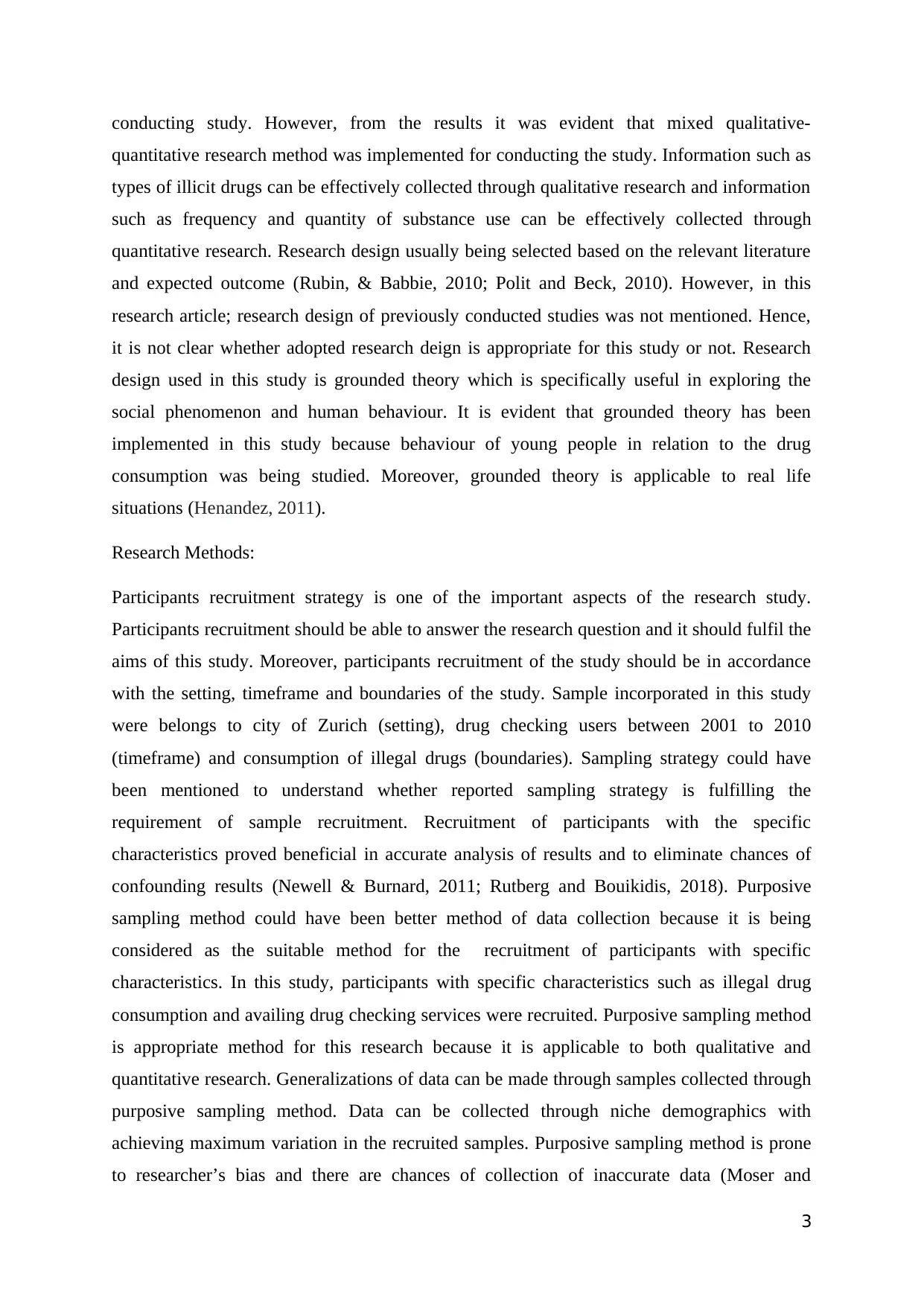
conducting study. However, from the results it was evident that mixed qualitative-
quantitative research method was implemented for conducting the study. Information such as
types of illicit drugs can be effectively collected through qualitative research and information
such as frequency and quantity of substance use can be effectively collected through
quantitative research. Research design usually being selected based on the relevant literature
and expected outcome (Rubin, & Babbie, 2010; Polit and Beck, 2010). However, in this
research article; research design of previously conducted studies was not mentioned. Hence,
it is not clear whether adopted research deign is appropriate for this study or not. Research
design used in this study is grounded theory which is specifically useful in exploring the
social phenomenon and human behaviour. It is evident that grounded theory has been
implemented in this study because behaviour of young people in relation to the drug
consumption was being studied. Moreover, grounded theory is applicable to real life
situations (Henandez, 2011).
Research Methods:
Participants recruitment strategy is one of the important aspects of the research study.
Participants recruitment should be able to answer the research question and it should fulfil the
aims of this study. Moreover, participants recruitment of the study should be in accordance
with the setting, timeframe and boundaries of the study. Sample incorporated in this study
were belongs to city of Zurich (setting), drug checking users between 2001 to 2010
(timeframe) and consumption of illegal drugs (boundaries). Sampling strategy could have
been mentioned to understand whether reported sampling strategy is fulfilling the
requirement of sample recruitment. Recruitment of participants with the specific
characteristics proved beneficial in accurate analysis of results and to eliminate chances of
confounding results (Newell & Burnard, 2011; Rutberg and Bouikidis, 2018). Purposive
sampling method could have been better method of data collection because it is being
considered as the suitable method for the recruitment of participants with specific
characteristics. In this study, participants with specific characteristics such as illegal drug
consumption and availing drug checking services were recruited. Purposive sampling method
is appropriate method for this research because it is applicable to both qualitative and
quantitative research. Generalizations of data can be made through samples collected through
purposive sampling method. Data can be collected through niche demographics with
achieving maximum variation in the recruited samples. Purposive sampling method is prone
to researcher’s bias and there are chances of collection of inaccurate data (Moser and
3
quantitative research method was implemented for conducting the study. Information such as
types of illicit drugs can be effectively collected through qualitative research and information
such as frequency and quantity of substance use can be effectively collected through
quantitative research. Research design usually being selected based on the relevant literature
and expected outcome (Rubin, & Babbie, 2010; Polit and Beck, 2010). However, in this
research article; research design of previously conducted studies was not mentioned. Hence,
it is not clear whether adopted research deign is appropriate for this study or not. Research
design used in this study is grounded theory which is specifically useful in exploring the
social phenomenon and human behaviour. It is evident that grounded theory has been
implemented in this study because behaviour of young people in relation to the drug
consumption was being studied. Moreover, grounded theory is applicable to real life
situations (Henandez, 2011).
Research Methods:
Participants recruitment strategy is one of the important aspects of the research study.
Participants recruitment should be able to answer the research question and it should fulfil the
aims of this study. Moreover, participants recruitment of the study should be in accordance
with the setting, timeframe and boundaries of the study. Sample incorporated in this study
were belongs to city of Zurich (setting), drug checking users between 2001 to 2010
(timeframe) and consumption of illegal drugs (boundaries). Sampling strategy could have
been mentioned to understand whether reported sampling strategy is fulfilling the
requirement of sample recruitment. Recruitment of participants with the specific
characteristics proved beneficial in accurate analysis of results and to eliminate chances of
confounding results (Newell & Burnard, 2011; Rutberg and Bouikidis, 2018). Purposive
sampling method could have been better method of data collection because it is being
considered as the suitable method for the recruitment of participants with specific
characteristics. In this study, participants with specific characteristics such as illegal drug
consumption and availing drug checking services were recruited. Purposive sampling method
is appropriate method for this research because it is applicable to both qualitative and
quantitative research. Generalizations of data can be made through samples collected through
purposive sampling method. Data can be collected through niche demographics with
achieving maximum variation in the recruited samples. Purposive sampling method is prone
to researcher’s bias and there are chances of collection of inaccurate data (Moser and
3
⊘ This is a preview!⊘
Do you want full access?
Subscribe today to unlock all pages.

Trusted by 1+ million students worldwide
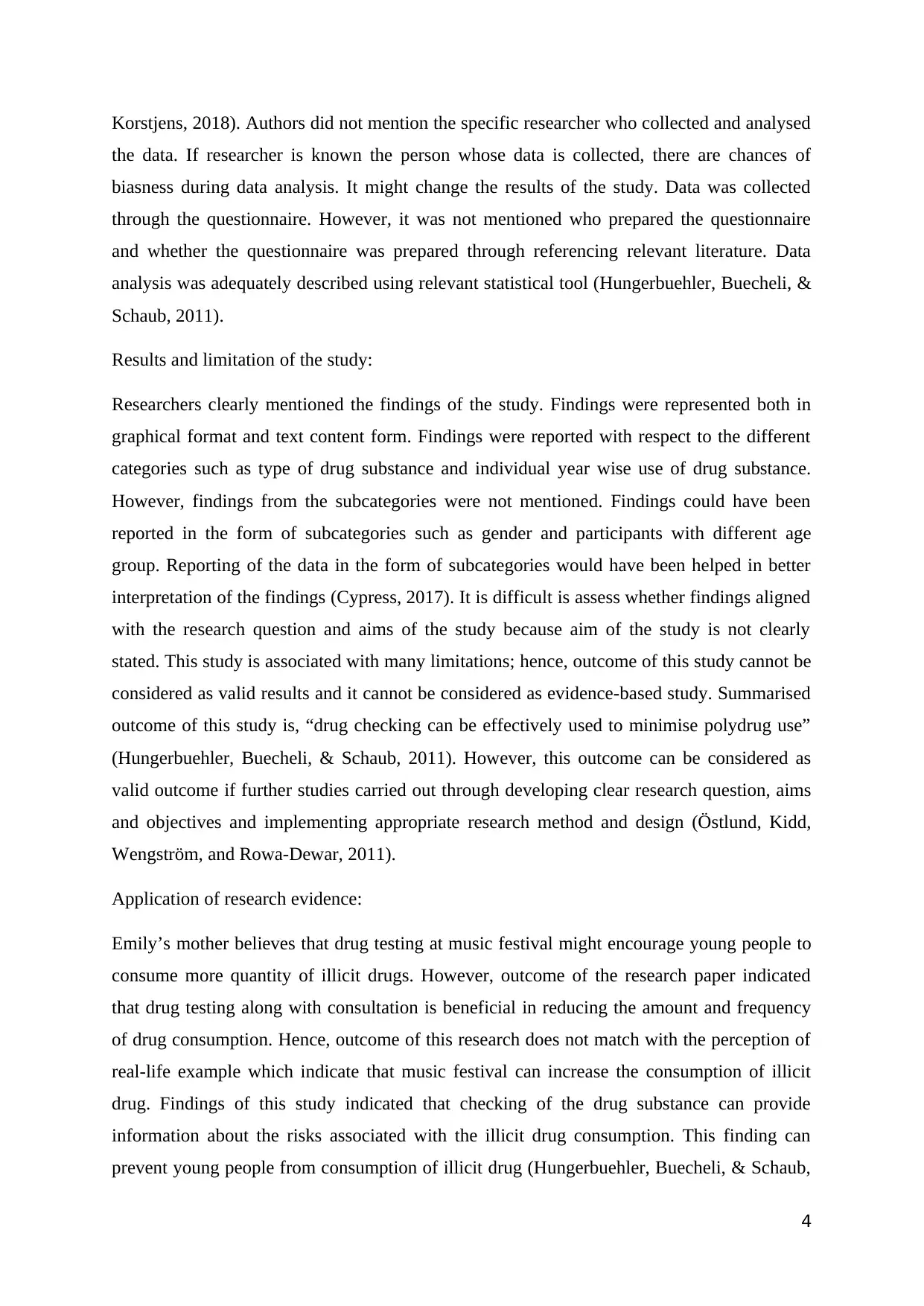
Korstjens, 2018). Authors did not mention the specific researcher who collected and analysed
the data. If researcher is known the person whose data is collected, there are chances of
biasness during data analysis. It might change the results of the study. Data was collected
through the questionnaire. However, it was not mentioned who prepared the questionnaire
and whether the questionnaire was prepared through referencing relevant literature. Data
analysis was adequately described using relevant statistical tool (Hungerbuehler, Buecheli, &
Schaub, 2011).
Results and limitation of the study:
Researchers clearly mentioned the findings of the study. Findings were represented both in
graphical format and text content form. Findings were reported with respect to the different
categories such as type of drug substance and individual year wise use of drug substance.
However, findings from the subcategories were not mentioned. Findings could have been
reported in the form of subcategories such as gender and participants with different age
group. Reporting of the data in the form of subcategories would have been helped in better
interpretation of the findings (Cypress, 2017). It is difficult is assess whether findings aligned
with the research question and aims of the study because aim of the study is not clearly
stated. This study is associated with many limitations; hence, outcome of this study cannot be
considered as valid results and it cannot be considered as evidence-based study. Summarised
outcome of this study is, “drug checking can be effectively used to minimise polydrug use”
(Hungerbuehler, Buecheli, & Schaub, 2011). However, this outcome can be considered as
valid outcome if further studies carried out through developing clear research question, aims
and objectives and implementing appropriate research method and design (Östlund, Kidd,
Wengström, and Rowa-Dewar, 2011).
Application of research evidence:
Emily’s mother believes that drug testing at music festival might encourage young people to
consume more quantity of illicit drugs. However, outcome of the research paper indicated
that drug testing along with consultation is beneficial in reducing the amount and frequency
of drug consumption. Hence, outcome of this research does not match with the perception of
real-life example which indicate that music festival can increase the consumption of illicit
drug. Findings of this study indicated that checking of the drug substance can provide
information about the risks associated with the illicit drug consumption. This finding can
prevent young people from consumption of illicit drug (Hungerbuehler, Buecheli, & Schaub,
4
the data. If researcher is known the person whose data is collected, there are chances of
biasness during data analysis. It might change the results of the study. Data was collected
through the questionnaire. However, it was not mentioned who prepared the questionnaire
and whether the questionnaire was prepared through referencing relevant literature. Data
analysis was adequately described using relevant statistical tool (Hungerbuehler, Buecheli, &
Schaub, 2011).
Results and limitation of the study:
Researchers clearly mentioned the findings of the study. Findings were represented both in
graphical format and text content form. Findings were reported with respect to the different
categories such as type of drug substance and individual year wise use of drug substance.
However, findings from the subcategories were not mentioned. Findings could have been
reported in the form of subcategories such as gender and participants with different age
group. Reporting of the data in the form of subcategories would have been helped in better
interpretation of the findings (Cypress, 2017). It is difficult is assess whether findings aligned
with the research question and aims of the study because aim of the study is not clearly
stated. This study is associated with many limitations; hence, outcome of this study cannot be
considered as valid results and it cannot be considered as evidence-based study. Summarised
outcome of this study is, “drug checking can be effectively used to minimise polydrug use”
(Hungerbuehler, Buecheli, & Schaub, 2011). However, this outcome can be considered as
valid outcome if further studies carried out through developing clear research question, aims
and objectives and implementing appropriate research method and design (Östlund, Kidd,
Wengström, and Rowa-Dewar, 2011).
Application of research evidence:
Emily’s mother believes that drug testing at music festival might encourage young people to
consume more quantity of illicit drugs. However, outcome of the research paper indicated
that drug testing along with consultation is beneficial in reducing the amount and frequency
of drug consumption. Hence, outcome of this research does not match with the perception of
real-life example which indicate that music festival can increase the consumption of illicit
drug. Findings of this study indicated that checking of the drug substance can provide
information about the risks associated with the illicit drug consumption. This finding can
prevent young people from consumption of illicit drug (Hungerbuehler, Buecheli, & Schaub,
4
Paraphrase This Document
Need a fresh take? Get an instant paraphrase of this document with our AI Paraphraser
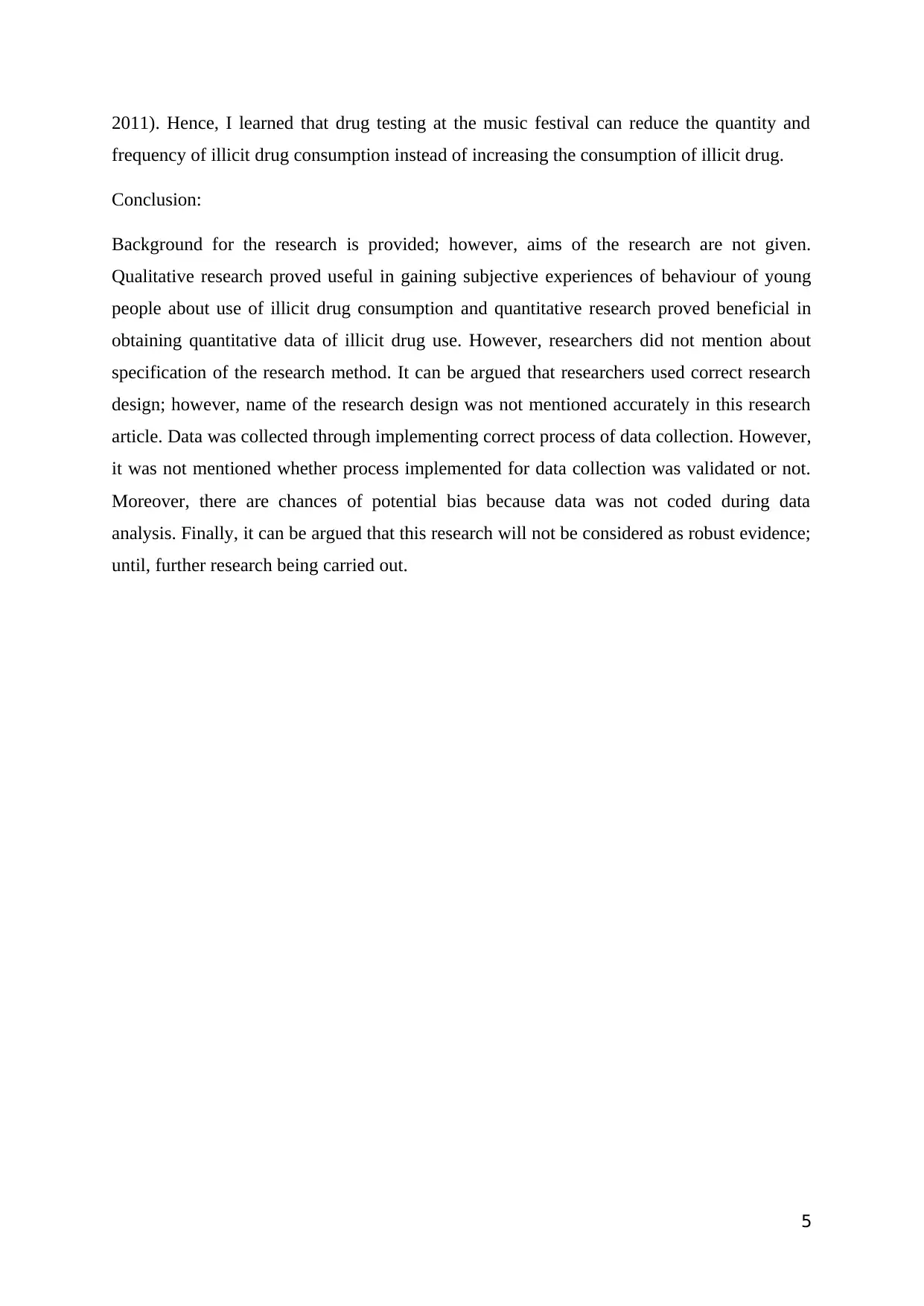
2011). Hence, I learned that drug testing at the music festival can reduce the quantity and
frequency of illicit drug consumption instead of increasing the consumption of illicit drug.
Conclusion:
Background for the research is provided; however, aims of the research are not given.
Qualitative research proved useful in gaining subjective experiences of behaviour of young
people about use of illicit drug consumption and quantitative research proved beneficial in
obtaining quantitative data of illicit drug use. However, researchers did not mention about
specification of the research method. It can be argued that researchers used correct research
design; however, name of the research design was not mentioned accurately in this research
article. Data was collected through implementing correct process of data collection. However,
it was not mentioned whether process implemented for data collection was validated or not.
Moreover, there are chances of potential bias because data was not coded during data
analysis. Finally, it can be argued that this research will not be considered as robust evidence;
until, further research being carried out.
5
frequency of illicit drug consumption instead of increasing the consumption of illicit drug.
Conclusion:
Background for the research is provided; however, aims of the research are not given.
Qualitative research proved useful in gaining subjective experiences of behaviour of young
people about use of illicit drug consumption and quantitative research proved beneficial in
obtaining quantitative data of illicit drug use. However, researchers did not mention about
specification of the research method. It can be argued that researchers used correct research
design; however, name of the research design was not mentioned accurately in this research
article. Data was collected through implementing correct process of data collection. However,
it was not mentioned whether process implemented for data collection was validated or not.
Moreover, there are chances of potential bias because data was not coded during data
analysis. Finally, it can be argued that this research will not be considered as robust evidence;
until, further research being carried out.
5
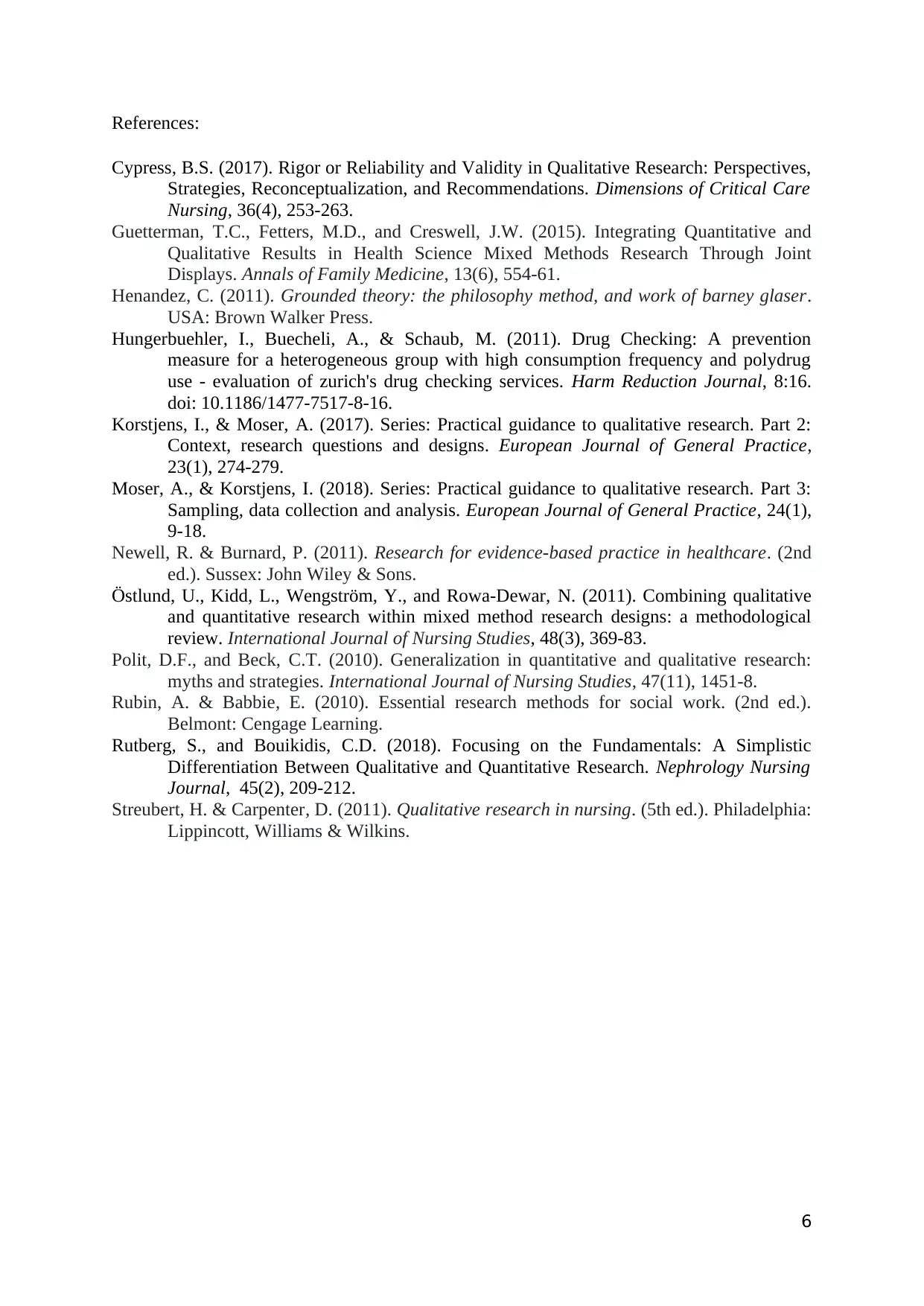
References:
Cypress, B.S. (2017). Rigor or Reliability and Validity in Qualitative Research: Perspectives,
Strategies, Reconceptualization, and Recommendations. Dimensions of Critical Care
Nursing, 36(4), 253-263.
Guetterman, T.C., Fetters, M.D., and Creswell, J.W. (2015). Integrating Quantitative and
Qualitative Results in Health Science Mixed Methods Research Through Joint
Displays. Annals of Family Medicine, 13(6), 554-61.
Henandez, C. (2011). Grounded theory: the philosophy method, and work of barney glaser.
USA: Brown Walker Press.
Hungerbuehler, I., Buecheli, A., & Schaub, M. (2011). Drug Checking: A prevention
measure for a heterogeneous group with high consumption frequency and polydrug
use - evaluation of zurich's drug checking services. Harm Reduction Journal, 8:16.
doi: 10.1186/1477-7517-8-16.
Korstjens, I., & Moser, A. (2017). Series: Practical guidance to qualitative research. Part 2:
Context, research questions and designs. European Journal of General Practice,
23(1), 274-279.
Moser, A., & Korstjens, I. (2018). Series: Practical guidance to qualitative research. Part 3:
Sampling, data collection and analysis. European Journal of General Practice, 24(1),
9-18.
Newell, R. & Burnard, P. (2011). Research for evidence-based practice in healthcare. (2nd
ed.). Sussex: John Wiley & Sons.
Östlund, U., Kidd, L., Wengström, Y., and Rowa-Dewar, N. (2011). Combining qualitative
and quantitative research within mixed method research designs: a methodological
review. International Journal of Nursing Studies, 48(3), 369-83.
Polit, D.F., and Beck, C.T. (2010). Generalization in quantitative and qualitative research:
myths and strategies. International Journal of Nursing Studies, 47(11), 1451-8.
Rubin, A. & Babbie, E. (2010). Essential research methods for social work. (2nd ed.).
Belmont: Cengage Learning.
Rutberg, S., and Bouikidis, C.D. (2018). Focusing on the Fundamentals: A Simplistic
Differentiation Between Qualitative and Quantitative Research. Nephrology Nursing
Journal, 45(2), 209-212.
Streubert, H. & Carpenter, D. (2011). Qualitative research in nursing. (5th ed.). Philadelphia:
Lippincott, Williams & Wilkins.
6
Cypress, B.S. (2017). Rigor or Reliability and Validity in Qualitative Research: Perspectives,
Strategies, Reconceptualization, and Recommendations. Dimensions of Critical Care
Nursing, 36(4), 253-263.
Guetterman, T.C., Fetters, M.D., and Creswell, J.W. (2015). Integrating Quantitative and
Qualitative Results in Health Science Mixed Methods Research Through Joint
Displays. Annals of Family Medicine, 13(6), 554-61.
Henandez, C. (2011). Grounded theory: the philosophy method, and work of barney glaser.
USA: Brown Walker Press.
Hungerbuehler, I., Buecheli, A., & Schaub, M. (2011). Drug Checking: A prevention
measure for a heterogeneous group with high consumption frequency and polydrug
use - evaluation of zurich's drug checking services. Harm Reduction Journal, 8:16.
doi: 10.1186/1477-7517-8-16.
Korstjens, I., & Moser, A. (2017). Series: Practical guidance to qualitative research. Part 2:
Context, research questions and designs. European Journal of General Practice,
23(1), 274-279.
Moser, A., & Korstjens, I. (2018). Series: Practical guidance to qualitative research. Part 3:
Sampling, data collection and analysis. European Journal of General Practice, 24(1),
9-18.
Newell, R. & Burnard, P. (2011). Research for evidence-based practice in healthcare. (2nd
ed.). Sussex: John Wiley & Sons.
Östlund, U., Kidd, L., Wengström, Y., and Rowa-Dewar, N. (2011). Combining qualitative
and quantitative research within mixed method research designs: a methodological
review. International Journal of Nursing Studies, 48(3), 369-83.
Polit, D.F., and Beck, C.T. (2010). Generalization in quantitative and qualitative research:
myths and strategies. International Journal of Nursing Studies, 47(11), 1451-8.
Rubin, A. & Babbie, E. (2010). Essential research methods for social work. (2nd ed.).
Belmont: Cengage Learning.
Rutberg, S., and Bouikidis, C.D. (2018). Focusing on the Fundamentals: A Simplistic
Differentiation Between Qualitative and Quantitative Research. Nephrology Nursing
Journal, 45(2), 209-212.
Streubert, H. & Carpenter, D. (2011). Qualitative research in nursing. (5th ed.). Philadelphia:
Lippincott, Williams & Wilkins.
6
⊘ This is a preview!⊘
Do you want full access?
Subscribe today to unlock all pages.

Trusted by 1+ million students worldwide
1 out of 6
Related Documents
Your All-in-One AI-Powered Toolkit for Academic Success.
+13062052269
info@desklib.com
Available 24*7 on WhatsApp / Email
![[object Object]](/_next/static/media/star-bottom.7253800d.svg)
Unlock your academic potential
Copyright © 2020–2025 A2Z Services. All Rights Reserved. Developed and managed by ZUCOL.





